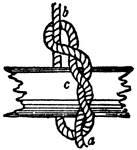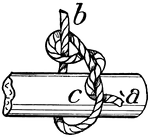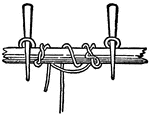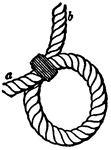The Knots ClipArt gallery offers 132 illustrations of different types of knots, showing detailed steps on how to handle the rope or thread and tie the knot. Although many of the knots included in this gallery have nautical applications, they are also used in many other fields.

Eye Splice in Three Steps
"Eye-splice. A sort of eye or circle formed by splicing the end of a rope into itself. a, one strand…

Short splice
"In making a short splice the ends of the ropes are unlaid for a short distance and brought together,…

Sprit-Sail Sheet Knot
"Sprit-Sail Sheet Knot -- This knot consists of a double wall and double crown made by the two ends,…
Fighting Stopper
"Naut., a contrivance, consisting of two wooden deadeyes and a rope lanyard, for quickly securing any…
!["Studding-sail halyard bend -- Similar to the [Fisherman's Bend], except that the end is tucked under the first round turn; this is more snug. A magnus hitch has two round turns and one on the other side of the standing part with the end through the bight."](https://etc.usf.edu/clipart/58300/58374/58374_studdingsail_mth.gif)
Studding-sail Halyard Bend
"Studding-sail halyard bend -- Similar to the [Fisherman's Bend], except that the end is tucked under…

Timber Hitch
"Timber Hitch -- Take the end of a of a rope round a spar then round the standing part b, then several…

Timber Hitch
To tie a timber hitch, take the end 'a' of a rope round a spar, then round the standing part 'b', then…

Turk's Head
"Turk's Head -- With fine line (very dry) make a clove hitch round the rope; cross the bights twice,…

Turning in a Dead-Eye Cutter-Stay Fashion
An illustration of a Turning in a Dead-Eye Cutter-Stay Fashion knot.

Two Half-Hitches
"Two Half-Hitches -- The half-hitch repeated; this is commonly used, and is capable of resisting to…

